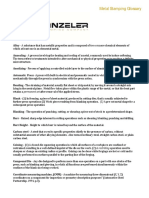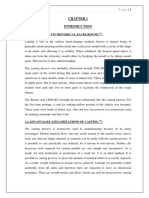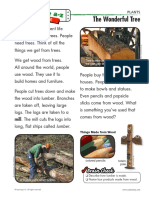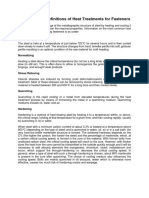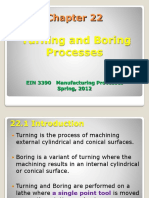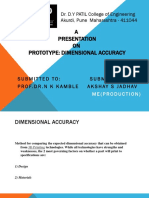Professional Documents
Culture Documents
Guideline - Painting, Coating & Corrosion Protection - Dulux - Mild Steel - Surface Preparation
Guideline - Painting, Coating & Corrosion Protection - Dulux - Mild Steel - Surface Preparation
Uploaded by
zinha_alCopyright
Available Formats
Share this document
Did you find this document useful?
Is this content inappropriate?
Report this DocumentCopyright:
Available Formats
Guideline - Painting, Coating & Corrosion Protection - Dulux - Mild Steel - Surface Preparation
Guideline - Painting, Coating & Corrosion Protection - Dulux - Mild Steel - Surface Preparation
Uploaded by
zinha_alCopyright:
Available Formats
THE CRITICAL STEP
In this Tech Note, our aim is to cover the most common type of
surface preparation used in preparing structural steel for long-term
corrosion protection.
The purpose of surface preparation of steel prior to application of a
protective coating system is two- fold:
To remove contaminants on the steel that may cause initiation or
continuation of the oxidation (rusting) process, and/or prevent adhesion of
the first coat to the steel and
To increase the profile and hence the surface area per square metre in
order to maximise the adhesion between the steel and the primer.
Contaminants can cause failure of the coating by preventing an Abrasive blast cleaning is the most effective and fast
adequate bond from occurring, and also may contribute to the rusting way of removing millscale and other contaminants
of the steel substrate.
A lower than desirable surface profile compromises the ability of the
coating to key into, and adhere to, the substrate resulting in lower
bond strength.
Furthermore, zinc rich primers rely on direct contact of the zinc metal
with the steel, and the higher the surface profile, the greater the
contact.
SURFACE PREPARATION STANDARD AS1627
The Australian Standard AS1627 series covers a number of surface
Millscale is a common cause of premature rust and
preparation processes. must be removed prior to painting
The method preferred by Dulux Protective Coatings within the
AS1627 series is the standard AS1627.4 - Abrasive Blast Cleaning.
A Class 2½ “Near White Metal” blast cleanliness, to match visual
standard Sa 2½ in AS1627.9, and to generate an angular surface
profile of 30 to 60 microns will be suitable for all types of steelwork
except perhaps steel for immersion. This method is far quicker and
more cost-effective than hand or power tool cleaning, and provides
maximum contact between the primer and the steel.
This method is also by far the most effective way to remove
millscale. (Refer to Tech Note 1.1.4 – Millscale)
SHARP EDGES ON STEELWORK
Sharp edges, laminations, burr marks and welds must all be
attended to during surface preparation.
Sharp edges cannot be painted over, as coatings will always pull
away from the sharp edge and pond on either side. The result is that
the edge will carry a far lower film build than is necessary for
Sharp edges must be ground off prior to painting
adequate corrosion protection, and will exhibit edge corrosion. To
overcome this problem, sharp edges must be ground off to achieve a
radius of at least 2 mm to ensure that the film build of the applied
coating will be uniform on the rounded edge.
Sharp edges are of particular concern on perforated steel or
expanded sheet steel, as the sharp edges are so extensive that
rounding them off is impractical. (See Tech Note 1.1.5 – Perforated
Metal).
SHOP PREPARATION
1. Wash and degrease all surfaces to be coated in accordance with
AS1627.1 with a free-rinsing, alkaline detergent, such as Gamlen CA
No. 1 in strict accordance with the manufacturer’s written instructions
and all safety warmings.
2. Wash with fresh potable water and ensure that all soluble salts are
removed in accordance with AS 3894.6 methods A&D.
3. Grind all sharp edges with a power tool to a minimum radius of 2 mm.
4. Power tool clean welds to AS1627.2 Class 2 to remove roughness.
Remove filings, preferably by vacuum or compressed air.
5. Abrasive blast clean all steel surfaces to be painted in accordance with
AS1627.4 to visual standard AS1627.9 Class 2.5 (equivalent to Spot abrasive blast cleaning is a practical method of
ISO8501-1, Sa 2.5: Very Thorough Blast-Cleaning). Use a non-metallic removing rust in situ.
medium that will generate a surface profile of 35 to 65 microns (as
tested to AS3894.5 Method A.)
APPLICATION OF COATING
1. Commence application within 4 hours of abrasive blasting or before
surface is contaminated, otherwise repeat abrasive blasting step.
2. Stripe coat welds, bolts, boltholes and all edges with primer before
application of full primer coat nominated in the Coating System section
of the specification.
3. Prior to application, ensure that the surface is free of contaminants
including oil, grease, dirt, dust, salt and any other deleterious materials
that will interfere with coating performance.
TREATMENT OF ON SITE WELDING
1. Remove weld spatter.
2. Power tool clean welds to AS1627.2 Class 2 to remove roughness.
Remove filings, preferably by vacuum or compressed air.
3. Prime welds immediately with the nominated primer before
contamination can reoccur. Ensure that the primer overlaps the sound MBX® Bristle Blaster® is ideal in awkward or difficult
adjacent coating by not less than 25mm or greater than 50mm. to access places.
4. Apply intermediate and topcoats over the primed welds to match the
surrounding coating system, overlapping the sound adjacent coating by
not less than 25mm or greater than 50mm.
ALTERNATIVE STANDARDS
In addition to the Australian Standard AS1627.4, there are similar
global standards. These are offered below for reference:
Brush-Blast AS1627.4 Class 1 NACE 4 SSPC – SP 7 Sa1
Commercial Blast AS1627.4 Class 2 NACE 3 SSPC –SP 6 Sa2
Near White Blast AS1627.4 Class 2.5 NACE 2 SSPC – SP10 Sa 2 – ½
White Blast AS1627.4 Class 3 NACE 1 SSPC- SP 5 Sa3
Ultra high pressure water jet will not create a new
For more information, please contact the Dulux Protective Coatings Technical profile, but will reveal the original profile of a blast
Consultant in your state. cleaned surface.
You might also like
- The Subtle Art of Not Giving a F*ck: A Counterintuitive Approach to Living a Good LifeFrom EverandThe Subtle Art of Not Giving a F*ck: A Counterintuitive Approach to Living a Good LifeRating: 4 out of 5 stars4/5 (5836)
- The Gifts of Imperfection: Let Go of Who You Think You're Supposed to Be and Embrace Who You AreFrom EverandThe Gifts of Imperfection: Let Go of Who You Think You're Supposed to Be and Embrace Who You AreRating: 4 out of 5 stars4/5 (1093)
- Never Split the Difference: Negotiating As If Your Life Depended On ItFrom EverandNever Split the Difference: Negotiating As If Your Life Depended On ItRating: 4.5 out of 5 stars4.5/5 (862)
- Grit: The Power of Passion and PerseveranceFrom EverandGrit: The Power of Passion and PerseveranceRating: 4 out of 5 stars4/5 (590)
- Hidden Figures: The American Dream and the Untold Story of the Black Women Mathematicians Who Helped Win the Space RaceFrom EverandHidden Figures: The American Dream and the Untold Story of the Black Women Mathematicians Who Helped Win the Space RaceRating: 4 out of 5 stars4/5 (903)
- Shoe Dog: A Memoir by the Creator of NikeFrom EverandShoe Dog: A Memoir by the Creator of NikeRating: 4.5 out of 5 stars4.5/5 (541)
- The Hard Thing About Hard Things: Building a Business When There Are No Easy AnswersFrom EverandThe Hard Thing About Hard Things: Building a Business When There Are No Easy AnswersRating: 4.5 out of 5 stars4.5/5 (351)
- Elon Musk: Tesla, SpaceX, and the Quest for a Fantastic FutureFrom EverandElon Musk: Tesla, SpaceX, and the Quest for a Fantastic FutureRating: 4.5 out of 5 stars4.5/5 (474)
- Her Body and Other Parties: StoriesFrom EverandHer Body and Other Parties: StoriesRating: 4 out of 5 stars4/5 (824)
- The Sympathizer: A Novel (Pulitzer Prize for Fiction)From EverandThe Sympathizer: A Novel (Pulitzer Prize for Fiction)Rating: 4.5 out of 5 stars4.5/5 (122)
- The Emperor of All Maladies: A Biography of CancerFrom EverandThe Emperor of All Maladies: A Biography of CancerRating: 4.5 out of 5 stars4.5/5 (271)
- The Little Book of Hygge: Danish Secrets to Happy LivingFrom EverandThe Little Book of Hygge: Danish Secrets to Happy LivingRating: 3.5 out of 5 stars3.5/5 (405)
- The World Is Flat 3.0: A Brief History of the Twenty-first CenturyFrom EverandThe World Is Flat 3.0: A Brief History of the Twenty-first CenturyRating: 3.5 out of 5 stars3.5/5 (2259)
- Devil in the Grove: Thurgood Marshall, the Groveland Boys, and the Dawn of a New AmericaFrom EverandDevil in the Grove: Thurgood Marshall, the Groveland Boys, and the Dawn of a New AmericaRating: 4.5 out of 5 stars4.5/5 (268)
- The Yellow House: A Memoir (2019 National Book Award Winner)From EverandThe Yellow House: A Memoir (2019 National Book Award Winner)Rating: 4 out of 5 stars4/5 (98)
- A Heartbreaking Work Of Staggering Genius: A Memoir Based on a True StoryFrom EverandA Heartbreaking Work Of Staggering Genius: A Memoir Based on a True StoryRating: 3.5 out of 5 stars3.5/5 (231)
- Team of Rivals: The Political Genius of Abraham LincolnFrom EverandTeam of Rivals: The Political Genius of Abraham LincolnRating: 4.5 out of 5 stars4.5/5 (234)
- On Fire: The (Burning) Case for a Green New DealFrom EverandOn Fire: The (Burning) Case for a Green New DealRating: 4 out of 5 stars4/5 (74)
- The Unwinding: An Inner History of the New AmericaFrom EverandThe Unwinding: An Inner History of the New AmericaRating: 4 out of 5 stars4/5 (45)
- Avesta - Some Factors Affecting Stainless Steel Corrosion in SeawaterDocument8 pagesAvesta - Some Factors Affecting Stainless Steel Corrosion in Seawaterzinha_alNo ratings yet
- Fives Webinar Presentation 24.06Document48 pagesFives Webinar Presentation 24.06YudhaAnantaWijaya100% (1)
- Ultratech Cement: Particulars Test Results Requirements ofDocument1 pageUltratech Cement: Particulars Test Results Requirements oflavekushNo ratings yet
- Publication - Painting, Coating & Corrosion Protection - Aremco Inc - High Temperature Materials - Coatings and AdhesivesDocument56 pagesPublication - Painting, Coating & Corrosion Protection - Aremco Inc - High Temperature Materials - Coatings and Adhesiveszinha_alNo ratings yet
- Publication - Painting, Coating & Corrosion Protection - Atlas Steels - "L", "H" and STANDARD GRADES of STAINLESS STEELS Technical NoteDocument4 pagesPublication - Painting, Coating & Corrosion Protection - Atlas Steels - "L", "H" and STANDARD GRADES of STAINLESS STEELS Technical Notezinha_alNo ratings yet
- Publication - Painting, Coating & Corrosion Protection - Pickling and Passivating 2015Document7 pagesPublication - Painting, Coating & Corrosion Protection - Pickling and Passivating 2015zinha_alNo ratings yet
- Publication - Painting, Coating & Corrosion Protection - AkzoNobel - International Paints - Mining and Minerals ApplicationsDocument44 pagesPublication - Painting, Coating & Corrosion Protection - AkzoNobel - International Paints - Mining and Minerals Applicationszinha_alNo ratings yet
- Publication - Painting, Coating & Corrosion Protection - Alfsen Og Gunderson - Dehumidifiers For The Oil and Gas ApplicationsDocument4 pagesPublication - Painting, Coating & Corrosion Protection - Alfsen Og Gunderson - Dehumidifiers For The Oil and Gas Applicationszinha_alNo ratings yet
- Presentation - Painting, Coating & Corrosion Protection - Preserving Bridge Suspension Span Cables Using DehumidifcationDocument34 pagesPresentation - Painting, Coating & Corrosion Protection - Preserving Bridge Suspension Span Cables Using Dehumidifcationzinha_alNo ratings yet
- Presentation - Painting, Coating & Corrosion Protection - en Engineering - Internal and External Corrosion and Cathodic ProtectionDocument34 pagesPresentation - Painting, Coating & Corrosion Protection - en Engineering - Internal and External Corrosion and Cathodic Protectionzinha_alNo ratings yet
- Avesta - Crevice Corrosion of Stainless Steels in SeawaterDocument8 pagesAvesta - Crevice Corrosion of Stainless Steels in Seawaterzinha_alNo ratings yet
- Presentation - Painting, Coating & Corrosion Protection - Beca - Cathodic ProtectionDocument56 pagesPresentation - Painting, Coating & Corrosion Protection - Beca - Cathodic Protectionzinha_al100% (1)
- Presentation - Painting, Coating & Corrosion Protection - Beca - Cathodic Protection - MiniDocument16 pagesPresentation - Painting, Coating & Corrosion Protection - Beca - Cathodic Protection - Minizinha_alNo ratings yet
- BHP - Table of Contents - List of Coatings For Structures, Piping and EquipmentDocument7 pagesBHP - Table of Contents - List of Coatings For Structures, Piping and Equipmentzinha_alNo ratings yet
- BRANZ - Study SR325 Update of New Zealand's Atmospheric Corrosivity Map - Part 2Document38 pagesBRANZ - Study SR325 Update of New Zealand's Atmospheric Corrosivity Map - Part 2zinha_alNo ratings yet
- NZTA - Protective Coatings For Steel BridgesDocument63 pagesNZTA - Protective Coatings For Steel Bridgeszinha_alNo ratings yet
- Luis MagneDocument19 pagesLuis Magnerichard gutierrezNo ratings yet
- Soldering & Brazing: Unit-IvDocument15 pagesSoldering & Brazing: Unit-IvRamu AmaraNo ratings yet
- ForkDocument5 pagesForkahharNo ratings yet
- MEPE34 Additive Manufacturing: Dr. N. Siva ShanmugamDocument17 pagesMEPE34 Additive Manufacturing: Dr. N. Siva ShanmugamJoe AllanNo ratings yet
- DRF 10119649 000Document5 pagesDRF 10119649 000Raphael LinoNo ratings yet
- Fara Diva Mustapa Department of Quantity Surveying Department of Quantity Surveying, Faculty of Built EnvironmentDocument12 pagesFara Diva Mustapa Department of Quantity Surveying Department of Quantity Surveying, Faculty of Built EnvironmentngjasonNo ratings yet
- Metal Stamping GlossaryDocument5 pagesMetal Stamping GlossaryMed HOUDNo ratings yet
- Bow PR 1Document3 pagesBow PR 1Valencia MyrhelleNo ratings yet
- Loose Piece Pattern CastingDocument29 pagesLoose Piece Pattern CastingshuklameNo ratings yet
- Plantsk-2 QR Wonderful Tree HighDocument1 pagePlantsk-2 QR Wonderful Tree HighLola LolaNo ratings yet
- Overview and Definitions of Heat Treatments For FastenersDocument2 pagesOverview and Definitions of Heat Treatments For Fastenerskaushik9shahNo ratings yet
- Turning and Boring ProcessesDocument39 pagesTurning and Boring ProcessesAdhanom G.No ratings yet
- Sand CastingDocument45 pagesSand CastingjmmshahNo ratings yet
- Rolling DefectsDocument6 pagesRolling DefectsAhmed Kaoud Sakr100% (1)
- Steel Making Process RoutesDocument7 pagesSteel Making Process Routespkn_pnt9950No ratings yet
- SmithyDocument71 pagesSmithyjitNo ratings yet
- MFG Tooling - 14 Welding FixtureDocument16 pagesMFG Tooling - 14 Welding FixtureAngel AjaNo ratings yet
- 224 XyronDocument1 page224 Xyrontabrizee nurNo ratings yet
- Calcul Débit Convoyeur Cru Sur Débit Four JourDocument1 pageCalcul Débit Convoyeur Cru Sur Débit Four JourbulentbulutNo ratings yet
- Shrinkage AllowanceDocument3 pagesShrinkage Allowanceghilman barranNo ratings yet
- W 2019 A - Merged - WatermarkDocument18 pagesW 2019 A - Merged - WatermarkDivya ChandewarNo ratings yet
- A Presentation ON Prototype: Dimensional Accuracy: Dr. D.Y PATIL College of Engineering Akurdi, Pune Maharashtra - 411044Document10 pagesA Presentation ON Prototype: Dimensional Accuracy: Dr. D.Y PATIL College of Engineering Akurdi, Pune Maharashtra - 411044AkshayJadhavNo ratings yet
- CR Mo 4Document2 pagesCR Mo 4Mohsen ParpinchiNo ratings yet
- Centrifugal CastingDocument3 pagesCentrifugal CastingBHãßkãr GúttíkøñdãNo ratings yet
- The Ceramic Shell Mold ProcessDocument18 pagesThe Ceramic Shell Mold ProcessAbhishek KumarNo ratings yet
- Metal PrimerDocument1 pageMetal PrimertUNNo ratings yet
- 1 Metal Forming RollingDocument85 pages1 Metal Forming Rollingpratik sidhuNo ratings yet
- Dissertation Meta AnalysisDocument4 pagesDissertation Meta AnalysisPaperWritersCollegeSingapore100% (1)































































